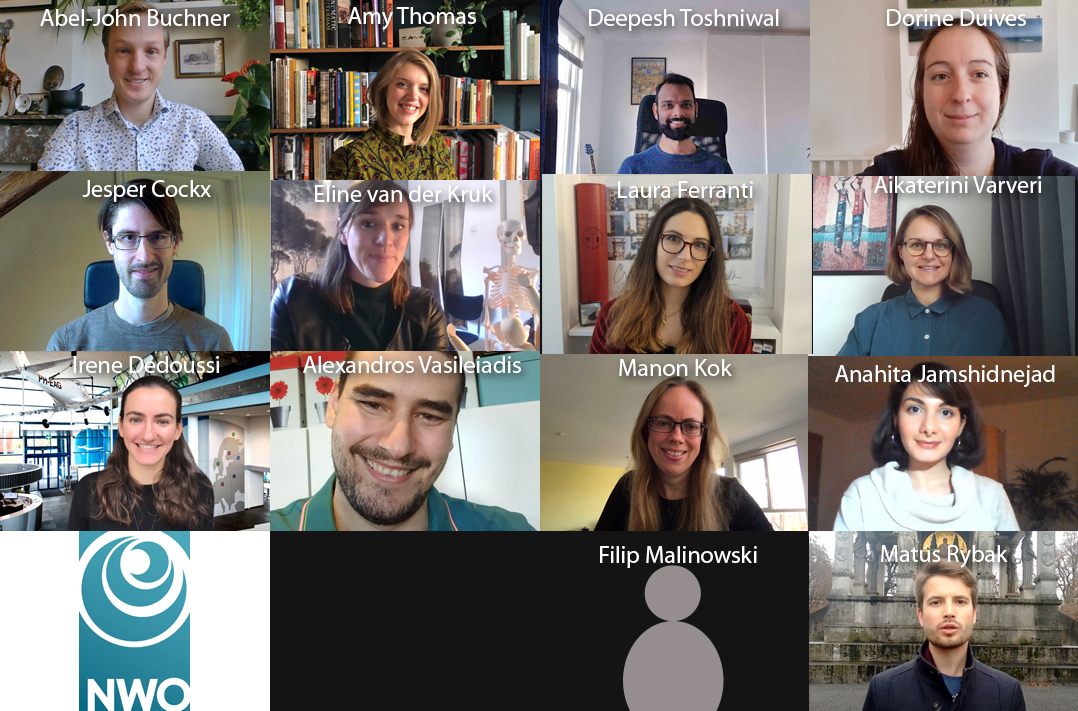The Dutch Research Council (NWO) has made 162 recent PhD researchers happy with a Veni grant of EUR 250,000 for three years. Fourteen of them are associated with TU Delft.
Screenshots van de Delftse onderzoekers. (Compilatie: TU Delta)
Who are these honoured TU Delft researchers and what are their plans?
Dr Abel-John Buchner (3mE) is planning to disrupt the reproduction of malaria mosquitoes. Mosquitoes mate very artistically while flying in a pairing dance that lasts at least 16 seconds. Buchner will record the synchronous flying of mating mosquitoes in great detail with the objective of disrupting the mating.
Dr Jesper Cockx’s (EEMCS) proposal is reminiscent of a matryoshka doll, a hollow wooden doll that contains dolls within ever smaller dolls. Cockx is working on improving the quality of computer programmes and wants to design software to test programming languages. Only error free programming languages can assess the accuracy of applications. So, he will develop a compact core programme that makes sure programming languages are error free.
Aeroplanes last for decades and because of this, the design needs to take into account the climate and the degree of pollution in the future, argues Dr Irene Dedoussi (AE). Her research will determine how these future conditions will impact current decision-making on making the aviation industry more sustainable.
Dr Dorine Duives (CEG) will run field studies to examine the effect of automated traffic signs such as matrix signs, arrows and traffic lights. A better understanding of how information influences crowds can improve safety in pedestrian areas.
Dr Laura Ferranti (3mE) is developing in-built information technology called Harmonia for anything that flies, drives and sails autonomously. Harmonia allows drones, cars and vessels to communicate with each other and with the people who move among them. The intention is for Harmonia to become a reliable mobile robot in the real world.
Dr Anahita Jamshidnejad (L&R) will design autonomous search and rescue drones for situations which are too dangerous for human rescuers. The biggest challenge is to make drones that take decisions autonomously in precarious situations.
Outdoors, GPS shows us the route between A and B, but there are as yet no generally available technologies that do that indoors, says Dr Manon Kok (3mE), so she is planning to design a 3D navigation aid for indoors. To do so, she is using the dimensions of magnetic fields and smartphone movements.
Majorana particles are one of the candidates to become quantum bits, the basic unit of the quantum computer that is under development. The fact that a Majorana cannot be disrupted is its most important feature as well as its largest obstacle in reading the quantum status. Dr Filip Malinowski (QuTech) will now use one single electron to sound out one Majorana particle.
Dr Eline van der Kruk (3mE) plans to design a computer simulation that predicts people’s future movement limitations, mostly as a result of the aging process or muscular disorders. A timely intervention may help people avoid over compensating their limitations, which in turn often leads to mobility problems and more rapid deterioration.
Over the last four years, Dr Matús Rybak (EEMCS) studied the birth of stars in the early universe at the Leidse Sterrewacht (Leiden planetarium). He will use the Veni grant to continue his research at the Terahertz group at TU Delft (EEMCS). This group is developing super conducting nano electronics to pick up signals from the beginning of the universe.
Historically, offices have been designed by men for men, says Dr. Amy Thomas (ABE). Using architectural- and interior-design-history, she asks: how has gender been articulated in office design since 1950? And to what extent has this affected workplace parity, and the the well-being, health, status and career development of women?
Computer simulations are indispensable in making predictions about complex processes such as the spreading of an epidemic. Dr Deepesh Toshniwal (EEMCS) will develop accurate computer simulations using a mathematical technique called splines that seamlessly merge different curves together. He will also theoretically underpin the application of the technique.
Dr Aikaterini Varveri (CEG) will go in search of a circular road surface that can be reused infinitely. The challenge is to develop climate-proof materials that are suitable for multiple reuse and recycling without affecting performance. To this end, Varveri will examine the interaction between the components at micro and macro level.
Hello, contact? In theory, solid-state batteries are better in terms of safety and performance than the current lithium-ion batteries. This is what Dr Alexandros Vasileiadis (AS) wrote in his research proposal. The problem with solid-state batteries is their poor electrical contacts. Vasileiadis will analyse this in detail in the hope to come up with design guidelines for this new type of battery.
Success percentage
The NWO awards Veni grants every year. This year, about 1,127 researchers submitted their research proposals. Of these, 162 were awarded grants. The success rate is thus 14%. The applications are evaluated through peer review by external experts from the relevant fields. This year’s Veni grants will award a total of EUR 41.5 million.
Veni grants are a part of the NWO’s talent development programme. There are subsidies for scientists at different points in their careers. Apart from the Venis, there are Vidi grants for experienced scientists and Vici grants for senior scientists. They are named after the message that Julius Caesar sent to the Senate in Rome after winning a battle: veni, vidi, vici. I came, I saw, I conquered.
Do you have a question or comment about this article?
j.w.wassink@tudelft.nl


Comments are closed.